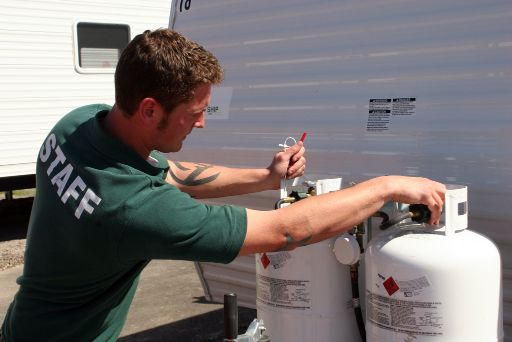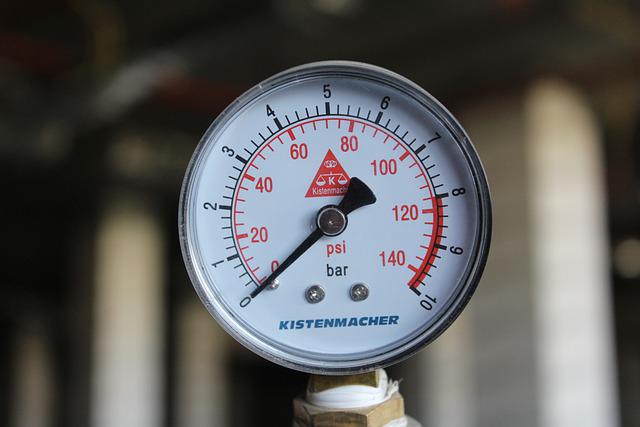
It is possible to connect two propane cylinders together. People often do this to increase the total propane capacity or to have a backup tank when one runs out. To connect two propane cylinders together, you will need the following equipment:
- Two propane tanks or cylinders: These will be the source of propane gas for your system. Ensure they are in good condition, without visible damage or rust, and have properly working valves.
- High-pressure propane hose: The hose is necessary to connect the tanks/cylinders to your appliances or propane system. It should be rated for propane use and have the appropriate connections for your tanks/cylinders and appliances. Using a hose specifically designed for propane is crucial for safety and to prevent leaks.
- Propane tank/cylinder connector: A tee or Y-connector, also known as a dual tank/cylinder connector or double tank/cylinder fitting, is used to connect two propane tanks or cylinders together. This connector typically has one input for each tank/cylinder and one output to connect to the hose. The connector is essential for joining the tanks/cylinders and ensuring a secure and leak-free connection.
- 2-Tank Propane tank/cylinder regulator: A special 2-tank regulator is needed to maintain a constant pressure for your propane system. When using two tanks/cylinders, you may require a dual-stage regulator, which can regulate pressure from both tanks/cylinders simultaneously, or an automatic changeover regulator, which switches from one tank/cylinder to another when the first one is empty. The regulator is critical for preventing overpressure and ensuring a stable and consistent flow of propane to your appliances or system.
To connect the cylinders:
- Ensure both propane cylinders are off and in a secure and stable position.
- Attach the tee or Y-connector to the valve of each propane cylinder.
- Connect the high-pressure propane hose to the output of the tee or Y-connector.
- Attach the regulator to the other end of the high-pressure hose.
- Connect the hose from the regulator to your appliance or propane system.
- Slowly open the valves on both propane cylinders, and check for any leaks by applying soapy water to the connections. If bubbles form, there is a leak. Tighten the connections or replace any damaged parts, then retest for leaks.
- If there are no leaks, the system is ready to use.
Always exercise caution when working with propane and follow all safety guidelines. Propane can be dangerous if mishandled. If you are unsure about any part of the process, consult a professional.
Benefits of a Dual Propane Tank System
1. Extended propane supply without the need for frequent replacements:
With two tanks connected, users have access to a larger volume of propane. This extended supply reduces the frequency of tank replacements, making it more convenient, especially for long-term use or in locations where propane refill or exchange is not immediately accessible.
2. Ensuring a backup: Preventing potential outages:
One of the main advantages of a dual propane tank system is redundancy. If one tank gets depleted, the other can automatically take over, ensuring an uninterrupted propane supply. This backup system is particularly beneficial during crucial times, such as in the middle of cooking or during cold nights when propane heating is required.
3. Optimal for high-demand scenarios: e.g., RVing, outdoor events, commercial use:
For situations where there is a consistent and high demand for propane, a dual tank system is invaluable. In recreational vehicles (RVs), for instance, propane powers multiple applications like cooking, heating, and refrigeration. Outdoor events, such as festivals or large gatherings, may also have several propane-powered appliances running simultaneously. Commercial spaces, like restaurants or workshops, also benefit from the dual system, ensuring operations run smoothly without the need to halt activities for a propane refill.
Cost Implications of a Dual Propane Tank System
1. Initial Setup Cost vs. Long-Term Savings:
- Upfront Costs: A dual propane tank system has a higher initial setup cost. This includes the price of the additional tank, the equipment needed to connect the two tanks, and perhaps a more specialized regulator.
- Long-Term Benefits: While you’ll spend more initially, there are advantages that can save you money in the long run. For instance, having a dual system means fewer trips to refill or replace tanks. Depending on how often you use propane, the transportation and service costs saved from fewer refills can add up over time. Furthermore, if your propane runs out at inconvenient times (like in the middle of the night), a dual system ensures you have a backup, reducing potential emergency refill costs or disruptions.
2. Dual vs. Single Tank Costs Over Time:
- Frequent Refills with a Single Tank: If you use propane regularly, a single tank will run out faster. This means you’ll need to refill it more often, leading to consistent costs related to refilling and potential downtime if you run out at critical times.
- Economies of Scale with Dual Tanks: With two tanks, you’re buying and storing more propane at once. Depending on your supplier, buying propane in larger quantities might qualify you for bulk rates or discounts. Additionally, the convenience of having a second tank automatically take over when the first runs out reduces the urgency to refill immediately, allowing you to choose a time that’s convenient and perhaps more cost-effective.
While the dual propane tank system has a higher upfront cost, its efficiency and convenience can lead to significant savings over time, especially for those who rely heavily on propane. It’s essential to consider both immediate costs and potential long-term savings when deciding on the best setup for your needs.
Would Connecting Result in Pressurization of the Tank
Connecting two propane cylinders or tanks together using the appropriate equipment and following safety guidelines should not result in overpressure or damage to the tanks. The key is using the correct propane regulator, which maintains a constant pressure for your propane system.
If you use a dual-stage regulator or an automatic changeover regulator, it will ensure that the pressure is controlled properly, preventing overpressure situations. These regulators are designed to manage the pressure from multiple tanks or cylinders connected together.
However, if you attempt to connect two propane tanks or cylinders without using a regulator or the proper equipment, it could lead to overpressure and potential damage to the tanks, cylinders, or connected appliances. Overpressure can also cause leaks or even an explosion, which could be very dangerous.
Always follow safety guidelines and use the proper equipment when connecting propane tanks or cylinders. If you are unsure about any part of the process or have concerns about overpressure, consult a professional for guidance.
It Is Not Advisable in DIY
Connecting two propane tanks or cylinders together is not advisable for most DIYers, especially if you don’t have experience working with propane systems. Propane can be dangerous if not handled properly, and mistakes can lead to leaks, fires, or explosions.
If you need to connect two propane tanks or cylinders together, it’s best to consult with a professional or someone experienced in propane systems to ensure the proper equipment is used and safety precautions are followed. You need to be aware also of the NFPA guidelines.
Technical Aspects of Connecting Propane Tanks
1. Equipment needed for a dual-tank setup:
- High-pressure hoses: These are crucial for safely transferring propane from the tank to the desired application, ensuring that the hose can withstand the pressure without any leaks.
- T-fittings and connectors: These components are necessary for splitting the flow of propane, allowing it to be directed from two tanks. They must be gas-rated to ensure safety.
- Dual tank regulator: This device helps to ensure that propane flows at a consistent rate from both tanks. A regulator maintains the pressure, ensuring that it doesn’t exceed recommended levels which could be hazardous.
2. Pressure considerations: It’s imperative to ensure a safe and consistent flow when using propane. This means regularly checking and maintaining the pressure. An imbalance or overly high pressure can be dangerous, potentially leading to leaks or explosions.
3. Automatic changeover systems: These systems are designed for seamless transitions. If one tank runs out, the system automatically switches over to draw propane from the other tank. This ensures an uninterrupted supply, especially crucial in scenarios where a constant gas supply is needed.
Ensure that Both are Level and in Even Surface
it is important to ensure that both propane tanks or cylinders are placed on a level and even surface when connecting them together. This helps prevent any instability, tipping, or potential damage to the tanks or cylinders that could occur if they were positioned on an uneven surface.
A stable and level surface for the tanks or cylinders is crucial for maintaining the safety and proper functioning of the propane system. An uneven surface could cause stress on the connections and hoses, increasing the risk of leaks or other issues.
Before setting up your propane tanks or cylinders, check the surface and make any necessary adjustments to ensure it is level and even. If you are using tanks or cylinders outdoors, choose a location with a solid, flat surface like concrete, brick, or a level area of compacted soil.
Always follow safety guidelines when working with propane tanks or cylinders and ensure that they are stable and secure on a level surface before connecting them together.
Here’s How to Operate The Dual Set Up
Common Mistakes to Avoid
| Mistake | Why it’s a mistake | How to avoid |
|---|---|---|
| Incorrect fittings leading to leaks. | Using wrong or mismatched fittings can result in propane leaks, posing a risk of fire or explosion. |
1. Double-check type and size of fittings. 2. Ensure tight and secure connection. 3. Use thread sealants designed for gas applications. |
| Using non-compatible equipment. | Using non-compatible parts might result in system inefficiencies, potential damage, or safety hazards. |
1. Read manufacturer guidelines. 2. Consult with a professional for compatibility. 3. Avoid modifying parts to make them fit. |
| Ignoring the importance of regular maintenance. | Regular wear and tear can lead to inefficiencies or potential hazards over time. |
1. Schedule regular inspections. 2. Check hoses and connections. 3. Clean and check tanks regularly. 4. Maintain a log for maintenance. |
If you want to learn more about other mistakes, we have an article about it: Here are the mistakes to avoid in doing the setup.
Let the Pro Do It For You
If you are considering connecting two propane tanks or cylinders together, it is highly recommended to let a professional or a qualified technician handle the job for you. This ensures that the setup is done safely, correctly, and in compliance with all relevant regulations and guidelines.
Professionals have the necessary experience, knowledge, and tools to properly connect and test the propane system, as well as to identify and address any potential issues. By having a professional handle the task, you reduce the risks associated with working with propane, such as leaks, fires, or explosions.
Always prioritize safety when working with propane systems, and don’t hesitate to reach out to a professional or a qualified technician for assistance in connecting two propane tanks or cylinders together.
To Make a Conclusion
It is possible to connect two propane tanks or cylinders together to increase the total propane capacity or to have a backup tank when one runs out. However, it is important to follow safety guidelines and use the proper equipment, including a high-pressure propane hose, a propane tank/cylinder connector (tee or Y-connector), and a propane regulator (dual-stage or automatic changeover).
Ensure both propane tanks or cylinders are in good condition, placed on a level and even surface, and connected securely with the appropriate fittings. Regularly inspect the system for leaks or damage, and always follow the manufacturer’s instructions for your propane equipment.
While it is possible to connect two propane tanks together, it is not advisable for inexperienced DIYers. Propane can be dangerous if not handled properly, and mistakes can lead to leaks, fires, or explosions. If you are unsure about any part of the process or lack experience with propane systems, consult a professional or a qualified technician for assistance.

Mike is an experienced propane technician with over 15 years of professional experience in the field. He has dedicated his career to helping customers with their propane needs, from installation to maintenance and repair. Together with Jeremy, he co-founded this website to provide useful information and guidance to customers seeking reliable propane services.



